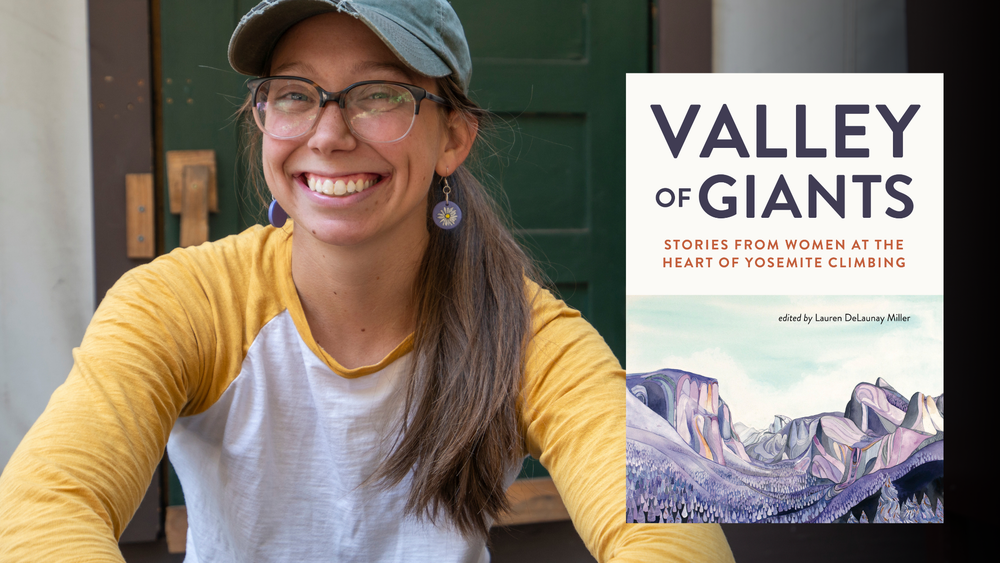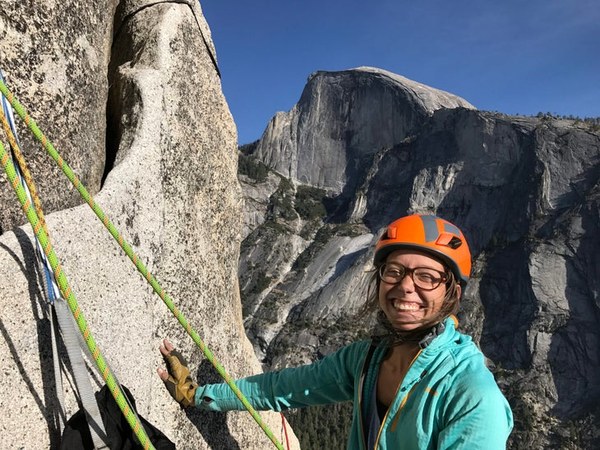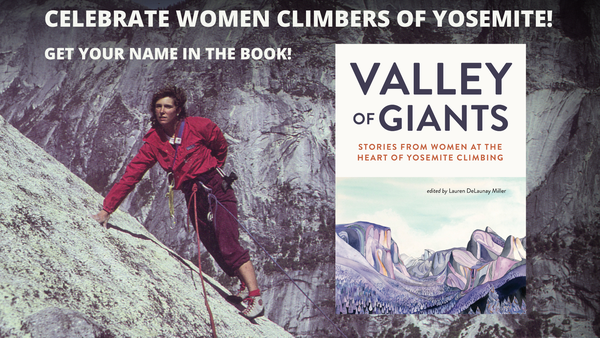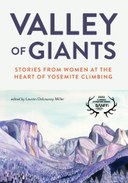
This blog is excerpted from a recent Climbing Magazine interview written by Madeline Taub and featuring Lauren DeLaunay Miller, author of the soon-to-be published anthology Valley of Giants: Women at the Heart of Yosemite Climbing. Until October 31, you can support the Mountaineers Books publishing program and get your name (or the name of a loved one) in Valley of Giants when you donate $100 or more by October 31.
LONG OVERDUE ANTHOLOGY HIGHLIGHTS WOMEN IN YOSEMITE CLIMBING HISTORY
By Madeline Taub
For Lauren DeLaunay Miller, climbing has always been about Yosemite. She discovered climbing in a doctor’s office after seeing the cover of National Geographic with Alex Honnold on the “Thank God Ledge” on Half Dome. Without even knowing what Yosemite was, the photo drew Miller in.
“I knew that from the day I stepped into the climbing gym - didn’t know how to belay yet - that I wanted to go to Yosemite, even just to see those walls someday,” Miller said.
Miller made it to Yosemite, eventually joining Yosemite Search and Rescue (YOSAR) for the summer 2018-2020 seasons. She currently holds many titles: graduate student at UC Berkeley, Vice President of the Bishop Area Climbers Coalition, Event Coordinator for the American Alpine Club’s Bishop Craggin’ Classic festival, and California Editor for the American Alpine Journal. Somehow, she has also found time to put together a new anthology, Valley of Giants: Stories from Women at the Heart of Yosemite Climbing, forthcoming from Mountaineers Books.
This anthology of essays, interviews, and excerpts features stories from almost 40 different female Yosemite climbers spanning from the 1930s until today - and it was born from Miller’s realization that even though women have been climbing in Yosemite since the beginning, they have largely been left out of Yosemite’s climbing history.
Miller sat down with me outside of Pacific Pipe Climbing Gym in Oakland, California, to talk about her book.
Why did you decide to write this book?
The writing of this book was kind of a long process; I probably spent just as long thinking about it as I did writing it. I think that’s because it took me a while to feel like I was the right person to do it, even though I’d always known that it was something that needed to exist. I go back to this Galen Rowell quote: it basically says that he makes no apologies for excluding women from climbing literature history because they weren’t involved in early ascents in Yosemite.* When I got to Yosemite, I found that that was not true and that there were inspiring women all around me who were telling their stories—but not with the same authority to write them down. There have been articles and that have done a lot to highlight women’s experiences, but I think that there’s something really important about a book that feels really concrete compared to other types of media.
[*Galen Rowell’s quote from the 1988 edition of his book, The Vertical World of Yosemite, reads: “Women are conspicuously absent from the climbs in this book. I have no apology to make here because it is not my place to change history. There simply were no major first ascents in Yosemite done by women during the formative years of the sport.”]
What surprised you while writing this book?
I think I felt surprised by how influential women were in the really early days, I kind of cut [the timeline] off at roped fifth class climbing, which was introduced in Yosemite in the 1930s. But in the 30s, the 40s, the 50s, early 60s, I was pretty surprised at how many women I was able to find from that period. It was interesting making these wonderful connections between what was happening in the climbing world at the time and what was happening in like a larger American cultural context. I mean, I’m not a historian by trade, but it doesn’t take a genius to see that, oh, in 1972 and 1973, we get Roe vs. Wade, we get Title IX, and we also get the first all-female ascent of El Cap. These things are not coincidences. This book is about climbing, of course, but it really showed me how much it’s not just about climbing.
 Lauren DeLaunay Miller on a one-day ascent of Skull Queen, Washington Column. Photo by Pato Berra.
Lauren DeLaunay Miller on a one-day ascent of Skull Queen, Washington Column. Photo by Pato Berra.
What makes the history of women in Yosemite unique, as compared to other climbing areas?
In Yosemite climbing, the lore and the storytelling component is huge. I’ve climbed all over the country and I’ve never come to anywhere where people are so steeped in that history. Every time you go to the crag in Yosemite, people refer to the routes by names. I would venture a bet that more people know the first ascensionists of the climb that they’re climbing on in Yosemite than anywhere else. History is much more present there than it is in other places, which made me feel like if you are going to start a project like this, Yosemite was the natural place to start, not just because that’s where I’ve spent most of my climbing career, but because that lore already exists—it just has gaping holes in it.
You mentioned some women were confused about why you wanted to include them in the book. Did you have any trouble convincing yourself that you should be included?
Yeah, that’s really interesting. I totally did. But at some point I felt like I’d just been in Yosemite waiting for this book to exist because I found it to be such an obviously good idea. And after years of it, I just looked around and was like, well, am I going to have to do this myself. I’m just going to get over it and I’m going to start talking to people and go from there. And I do feel like my experiences working in Yosemite were helpful in making the personal connections that I needed to convince some of these super humble women to write for it. But yeah, I had to fight imposter syndrome the whole time. All my climbing in Yosemite has been defined by fighting imposter syndrome. It’s just such a big place with so many big personalities and so many incredible climbers that it’s hard to ever feel that you’re the one that should be doing this.
Is there anything else you’d like to add?
If anyone works in a place of power where you’re in control of who gets to speak or who gets to write, to just pause and think about what has existed before that might have limited people from sharing their own experiences and what we’re doing to uphold the idea that only the very, very best get to share their experiences. Within climbing, we often really want to know what people are doing at the cutting edge of the sport, and that’s totally normal and fair, but when we stop the conversation there, we miss out on a lot of people.
Madeline Taub is a freelance writer and climber based in Oakland, CA. You can find her at madelinetaub.com and on Twitter @Madrtz.
More about Mountaineers Books
As an independent, mission-focused nonprofit publisher, Mountaineers Books is committed to broadly sharing the transformative power of the outdoors from unique perspectives like the women included in this collection. But book sales alone are not enough to achieve this mission. Your support allows us to extend our reach to new communities; support high quality, ambitious books that may otherwise not be published; champion emerging authors; support community events, partnerships, and exhibits; and produce our books in an environmentally sustainable way. Thank you.
 Erika Lundahl
Erika Lundahl

